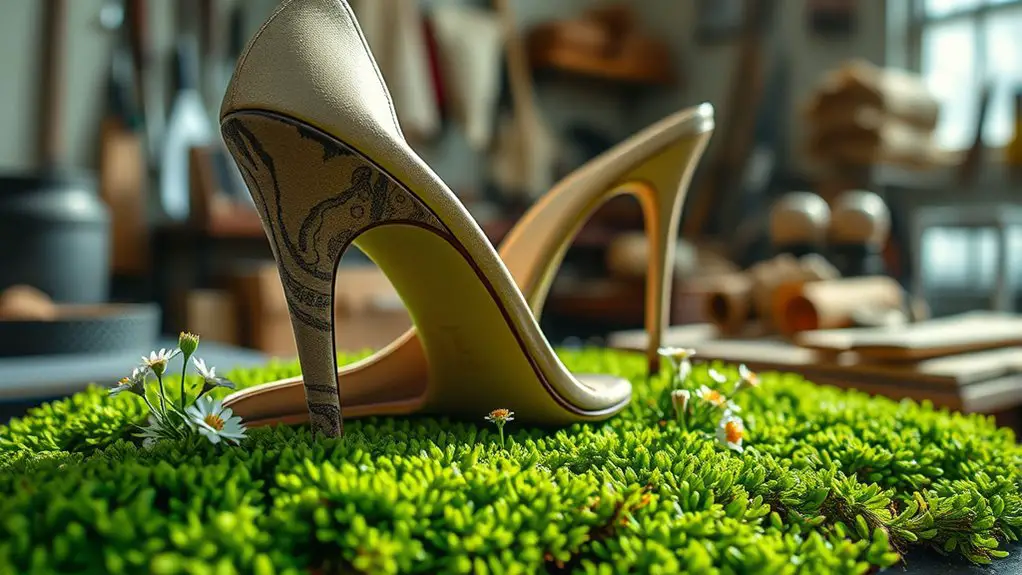Sustainability is transforming heel manufacturing by encouraging the use of eco-friendly materials and innovative designs. Biodegradable plastics, natural fibers, and plant-based adhesives reduce environmental impact. Companies are prioritizing ethical labor practices, ensuring fair wages and safe conditions, which enhances employee productivity. Additionally, consumer demand for sustainable products drives brands to adopt greener practices. However, challenges like regulatory hurdles and cost implications persist. There’s much more to uncover about the future of sustainable heel manufacturing.
The Shift to Eco-Friendly Materials

As consumers increasingly demand sustainable products, heel manufacturers are pivoting towards eco-friendly materials to meet these expectations. This shift is evident in the growing adoption of biodegradable plastics, which offer a promising alternative to traditional petroleum-based materials. These plastics break down more easily in the environment, reducing the long-term impact of discarded footwear.
Additionally, natural fibers like organic cotton, hemp, and jute are being integrated into heel production. These materials not only contribute to a lower carbon footprint but also enhance the product’s biodegradability. Research shows that consumers are more likely to support brands utilizing these sustainable options, reflecting a broader trend towards environmental responsibility in the fashion industry.
Innovations in Sustainable Design
While traditional design practices often prioritize aesthetics over sustainability, recent innovations in sustainable design are reshaping heel manufacturing by integrating eco-conscious principles into every stage of production. You’ll find that designers are increasingly incorporating biodegradable heels, which not only reduce waste but also enhance the lifespan of the product’s environmental impact. This shift allows brands to maintain sustainable aesthetics—a balance of beauty and functionality—without compromising on style.
Moreover, advancements in technology enable the use of recycled materials, creating a circular economy within the industry. Brands are now experimenting with plant-based adhesives and natural dyes, resulting in products that are both visually appealing and environmentally friendly. By focusing on these innovations, heel manufacturers can attract a new generation of consumers who value sustainability. Ultimately, these innovations not only reflect a commitment to ecological responsibility but also redefine what it means to create stylish footwear in today’s market.
Ethical Labor Practices in Heel Production

When considering ethical labor practices in heel production, it’s vital to examine fair wages and benefits for workers, as these directly impact their quality of life. Additionally, safe working conditions are non-negotiable to guarantee the health and well-being of those involved in manufacturing. Finally, supply chain transparency is essential for holding brands accountable and fostering trust with consumers.
Fair Wages and Benefits
Ensuring fair wages and benefits in heel manufacturing is essential not only for ethical labor practices but also for the long-term sustainability of the industry. When you prioritize wage equity, you’re fostering an environment where employee satisfaction thrives. Research shows that fair compensation directly correlates with productivity; happy employees are more motivated and engaged. By offering competitive wages and extensive benefits, manufacturers can attract and retain skilled workers, reducing turnover costs and enhancing overall efficiency. Additionally, when workers feel valued, they’re more likely to contribute positively to their workplace culture. This commitment to ethical labor practices not only enhances brand reputation but also aligns with consumer expectations for sustainability, ensuring the industry’s viability in a socially conscious market.
Safe Working Conditions
Safe working conditions are integral to ethical labor practices in heel production, as they not only protect employees but also enhance overall productivity. Prioritizing employee safety involves implementing rigorous safety protocols and training programs tailored to specific manufacturing processes. Research shows that companies with a strong focus on workplace health see reduced injury rates, leading to fewer absences and lower healthcare costs. This investment in safety not only fosters a positive work environment but also boosts employee morale and retention. Furthermore, ensuring proper ventilation, ergonomic workstations, and access to personal protective equipment can greatly improve overall workplace health. By embracing these practices, heel manufacturers can cultivate a sustainable workforce that contributes to both ethical standards and long-term business success.
Supply Chain Transparency
A commitment to ethical labor practices extends beyond workplace safety; it encompasses the entire supply chain, where transparency plays a pivotal role. By implementing supply chain mapping, you can trace every step of the heel production process, ensuring that all materials are sourced responsibly. This level of scrutiny allows you to adopt sourcing strategies that prioritize ethical suppliers, reducing the risk of labor exploitation. Transparency not only builds consumer trust but also encourages collaboration among manufacturers to uphold high standards. As you navigate your supply chain, consider the impact of your choices on labor practices, and remember that ethical decisions today can lead to sustainable success tomorrow. Prioritizing transparency is essential for a more equitable industry.
Reducing Waste in Manufacturing Processes

While many manufacturers prioritize efficiency, reducing waste in heel manufacturing processes is equally essential for fostering sustainability. Implementing waste reduction techniques, such as lean manufacturing, can considerably lower material and energy consumption. By optimizing production workflows and minimizing excess, you not only save resources but also enhance profitability.
Here’s a quick overview of key waste reduction strategies:
| Strategy | Description |
|---|---|
| Process Optimization | Streamlining operations to eliminate bottlenecks. |
| Material Reuse | Utilizing off-cuts or scraps in new products. |
| Energy Efficiency | Upgrading machinery to reduce power consumption. |
| Employee Training | Educating staff on sustainable practices. |
The Role of Consumer Demand in Sustainability
As consumer awareness regarding environmental issues grows, the demand for sustainable products in the heel manufacturing sector becomes increasingly significant. You’re likely noticing how your purchasing power influences brands to adopt eco-friendly practices. When you choose sustainable heels, you’re not just making a fashion statement; you’re driving change in the industry.
Research indicates that consumers are now prioritizing brands that commit to sustainability, prompting manufacturers to innovate materials and processes. This shift in demand encourages companies to explore alternatives like recycled materials or ethical sourcing, directly impacting their production methods.
Moreover, your willingness to pay a premium for sustainable products reinforces this trend, allowing brands to invest in greener technologies. As a result, the heel manufacturing sector is evolving, aligning with your values and expectations. Basically, your choices as a consumer are pivotal in shaping a more sustainable future for the industry.
Case Studies of Sustainable Heel Brands
Sustainable heel brands are stepping up to meet the rising consumer demand for eco-friendly products, showcasing innovative practices that prioritize both style and environmental responsibility. These brands are not just about aesthetics; they’re committed to sustainable branding and consumer education, ensuring that you understand the impact of your choices.
- Use of Recycled Materials: Many brands incorporate upcycled plastics and organic textiles, reducing waste and promoting circularity in fashion.
- Ethical Manufacturing Processes: Transparency in sourcing and labor practices builds trust, allowing consumers to make informed decisions.
- Carbon Footprint Reduction: Some brands utilize renewable energy and offset programs to minimize their environmental impact during production.
Through these strategies, sustainable heel brands demonstrate that you can enjoy stylish footwear while contributing to a healthier planet. By prioritizing education and transparency, they empower you to make choices that align with your values.
Challenges in Implementing Sustainable Practices
Implementing sustainable practices in heel manufacturing presents several significant challenges that brands must navigate to achieve their environmental goals. One major obstacle is the regulatory hurdles that companies face, as they often need to comply with a complex web of environmental regulations. These regulations can vary by region, making it difficult for brands to maintain consistency in compliance across different markets.
Additionally, there are substantial cost implications associated with shifting to sustainable materials and processes. While investing in eco-friendly materials may reduce long-term costs, the upfront expenses can be intimidating. Brands may find themselves weighing the short-term financial strain against potential long-term benefits, which can lead to hesitation in adopting sustainable practices.
Ultimately, overcoming these challenges requires a strategic approach, balancing regulatory compliance and cost considerations while remaining committed to sustainability. Success in this arena can enhance a brand’s reputation and marketability, aligning with consumer demand for environmentally responsible products.
The Future of Sustainable Heel Manufacturing
As you consider the future of sustainable heel manufacturing, you’ll find that innovation in eco-friendly materials is essential for reducing environmental impact. Energy-efficient production techniques are also important, enabling manufacturers to minimize resource consumption while maintaining quality. Finally, embracing circular economy practices can transform waste into valuable resources, fostering a more sustainable industry moving forward.
Eco-Friendly Materials Innovation
While the fashion industry often grapples with the environmental impact of its materials, innovations in eco-friendly options are reshaping heel manufacturing for the better. As you explore the future of sustainable heels, consider how these advancements are revolutionizing the market:
- Biodegradable components: These materials break down naturally, reducing landfill waste.
- Recycled materials: Incorporating post-consumer waste into heel production helps minimize resource extraction and pollution.
- Plant-based alternatives: Innovations in sustainable sourcing lead to less harmful environmental footprints.
Energy-Efficient Production Techniques
Although the heel manufacturing industry has traditionally relied on energy-intensive processes, a shift towards energy-efficient production techniques is emerging as a key component of sustainable practices. By adopting advanced technologies such as automated machinery and smart manufacturing systems, you can greatly enhance energy conservation. These methods not only reduce energy consumption but also promote production optimization, streamlining workflows and minimizing waste. Implementing practices like heat recovery systems and renewable energy sources can further decrease your carbon footprint. The integration of data analytics allows for continuous monitoring and improvement, ensuring that energy usage aligns with sustainability goals. Ultimately, embracing energy-efficient production techniques positions your brand as a leader in sustainability, appealing to environmentally conscious consumers and fostering long-term viability.
Circular Economy Practices
Embracing circular economy practices is essential for the future of sustainable heel manufacturing, especially as consumers increasingly demand accountability from brands. By adopting these practices, companies can mitigate waste and enhance the lifecycle of their products. Key strategies include:
- Implementing recycling programs to reclaim materials from discarded heels, reducing reliance on virgin resources.
- Focusing on product longevity by designing heels that withstand wear while remaining stylish and functional, encouraging consumers to invest in quality over quantity.
- Promoting take-back initiatives, allowing customers to return used products for refurbishment or recycling.
These approaches not only cater to eco-conscious consumers but also foster innovation within the industry. As you engage with these practices, you’ll contribute to a more sustainable future in heel manufacturing.
Frequently Asked Questions
What Are the Environmental Benefits of Sustainable Heel Manufacturing?
Sustainable heel manufacturing offers significant environmental benefits. By using eco-friendly materials, you’re reducing harmful emissions and resource depletion. Plus, waste reduction practices minimize landfill contributions, creating a more responsible industry that aligns with global sustainability goals.
How Do Sustainable Heels Compare in Price to Traditional Options?
Sustainable heels often have higher upfront costs due to eco-friendly materials, but sustainable pricing can balance over time with durability and lower environmental impact. Consider these alternatives for long-term savings and ethical consumerism benefits.
Can Sustainable Materials Affect the Durability of Heels?
Sustainable materials can influence durability, often leading to longevity trade-offs. While some eco-friendly options may offer similar material performance, others might compromise strength, necessitating careful consideration of specific materials used in heel manufacturing to guarantee durability.
Are There Certifications for Sustainable Heel Products?
Imagine walking on clouds of responsibility. Yes, there’re sustainable certifications for heel products that meet eco-friendly standards. These certifications guarantee your choices reflect a commitment to quality, ethics, and environmental stewardship in fashion.
How Can Consumers Identify Truly Sustainable Heel Brands?
To identify truly sustainable heel brands, you should look for brand transparency and consumer education. Research their sourcing practices, materials used, and certifications. Brands committed to sustainability often provide detailed information about their environmental impact and ethical standards.



